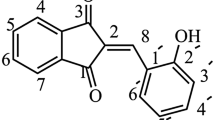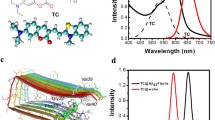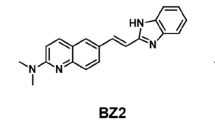Abstract
The pathogenesis of Parkinson’s disease that is the second most common neurodegenerative disease is associated with formation of different aggregates of α-synuclein (ASN), namely oligomers and amyloid fibrils. Current research is aimed on the design of fluorescent dyes for the detection of oligomeric aggregates, which are considered to be toxic and morbific spices. Fluorescent properties of series of benzothiazole trimethine and pentamethine cyanines were characterized in free state and in presence of monomeric, oligomeric and fibrilar ASN. The dyes with wide aromatic systems and bulky phenyl and alkyl substituents that are potentially able to interact with hydrophobic regions of oligomeric aggregates were selected for the studies. For majority of studied dyes noticeable changes in fluorescence characteristics were shown in the presence of fibrillar or oligomeric ASN, while the dyes slightly responded on the presence of monomeric protein. For pentamethine cyanine SL-631 and trimethine cyanine SH-299 certain specificity to oligomeric aggregates over fibrils was observed. Using these dyes at 10−6 M concentration permits the detection of oligomeric ASN in the concentrations range of at least 0.2–2 microM. Pentamethine cyanine SL-631 is proposed as dye for fluorescent detection of oligomeric aggregates of ASN, while trimethine cyanine SH-299 is shown to be a sensitive probe both on oligomeric and fibrillar ASN. It is proposed that wide aromatic system of SL-631 pentamethine dye molecule could better fix on the less dense and structured oligomeric formation, while less bulky and more “crescent-shape” molecule of trimethine dye SH-299 could easier enter into the groove of beta-pleated structure.




Similar content being viewed by others
References
Spillantini MG, Schmidt ML, Lee VM, Trojanowski JQ, Jakes R, Goedert M (1997) Alpha-synuclein in Lewy bodies. Nature 388:839–840
Spillantini MG, Crowther RA, Jakes R, Hasegawa M, Goedert M (1998) Alpha-synuclein in filamentous inclusions of Lewy bodies from Parkinson’s disease and dementia with lewy bodies. Proc Natl Acad Sci India USA 95:6469–6473
Li HT, Du HN, Tang L, Hu J, Hu HY (2002) Structural transformation and aggregation of human alpha-synuclein in trifluoroethanol: non-amyloid component sequence is essential and beta-sheet forma tion is prerequisite to aggregation. Biopolymers 64:221–226
Hoyer W, Cherny D, Subramaniam V, Jovin TM (2004) Impact of the acidic C-terminal region comprising amino acids 109–140 on α-synuclein aggregation in vitro. Biochemistry 43:16233–16242
Lashuel HA, Petre BM, Wall J, Simon M, Nowak RJ, Walz T, Lansbury PT Jr (2002) Alpha-synuclein, especially the Parkinson’s disease-associated mutants, forms pore-like annular and tubular protofibrils. J Mol Biol 322:1089–1102
Volles MJ, Lansbury PT Jr (2003) Zeroing in on the pathogenic form of alpha-synuclein and its mechanism of neurotoxicity in Parkinson’s disease. Biochemistry 42:7871–7878
Yamin G, Glaser CB, Uversky VN, Fink AL (2003) Certain metals trigger fibrillation of methionine-oxidized α-synuclein. J Biol Chem 278:27630–27635
Wood SJ, Wypych J, Steavenson S, Louis JC, Citron M, Biere AL (1999) Alpha-synuclein fibrillogenesis is nucleation-dependent. Implications for the pathogenesis of Parkinson’s disease. J Biol Chem 274:19509–19512
Volles MJ, Lee SJ, Rochet JC, Shtilerman MD, Ding TT, Kessler JC, Lansbury PT Jr (2001) Vesicle permeabilization by protofibrillar alpha-synuclein: implications for the pathogenesis and treatment of Parkinson’s disease. Biochemistry 40:7812–7819
Cookson MR (2009) α-Synuclein and neuronal cell death. Mol Neurodegener 4:9–14
Apetri MM, Maiti NC, Zagorski MG, Carey PR, Anderson VE (2006) Secondary structure of alpha-synuclein oligomers:Characterization by Raman and atomic force microscopy. J Mol Biol 355:63–71
Conway KA, Lee SJ, Rochet JC, Ding TT, Williamson RE, Lansbury PT Jr (2000) Acceleration of oligomerization, not fibrillization, is a shared property of both alpha-synuclein mutations linked to early-onset Parkinson’s disease: implications for pathogenesis and therapy. Proc Natl Acad Sci U S A 97:571–576
Lashuel HA, Petre BM, Wall J, Simon M, Nowak RJ, Walz T, Lansbury PT Jr (2002) Alpha-synuclein, especially the Parkinson’s disease-associated mutants, forms porelike annular and tubular protofibrils. J Mol Biol 322:1089–1102
Ding TT, Lee SJ, Rochet JC, Lansbury PT (2002) Annular alpha-synuclein proto_brils are produced when spherical protofibrils are incubated in solution or bound to brain-derived membranes. Biochemistry 41:10209–10217
Quist A, Doudevski I, Lin H, Azimova R, Ng D, Frangione B, Kagan B, Ghiso J, Lal R (2005) Amyloid ion channels:a common structural link for protein-misfolding disease. Proc Natl Acad Sci U S A 102:10427–10432
Kaylor J, Bodner N, Edridge S, Yamin G, Hong DP, Fink AL (2005) Characterization of oligomeric intermediates in alpha-synuclein fibrillation: FRET studies of Y125W/Y133F/Y136F alpha-synuclein. J Mol Biol 353:357–372
Rooijen van, Bart Dirk (2009) Structural and functional insights into interactions of oligomeric α-synuclein with lipid membranes. thesis. http://doc.utwente.nl/68582/
Lindgren M, Sörgjerd K, Hammarström P (2005) Detection and characterization of aggregates, prefibrillar amyloidogenic oligomers, and protofibrils using fluorescence spectroscopy. Biophys J 88:4200–4212
Hawe A, Sutter M, Jiskoot W (2008) Extrinsic fluorescent dyes as tools for protein characterization. Pharm Res 25(7):1487–1499
Eisert R, Felau L, Brown LR (2006) Methods for enhancing the accuracy and reproducibility of Congo red and Thioflavin T assays. Anal Biochem 353:144–146
Volkova KD, Kovalska VB, Balanda AO, Losytskyy MYu, Golub AG, Vermeij RJ, Subramaniam V, Tolmachev OI, Yarmoluk SM (2008) Specific fluorescent detection of fibrillar alpha-synuclein using mono- and trimethine cyanine dyes. Bioorg Med Chem 16:1452–1459
Volkova KD, Kovalska VB, Segers-Nolten GM, Veldhuis G, Subramaniam V, Yarmoluk SM (2009) Explorations of the application of cyanine dyes for quantitative α-synuclein detection. Biotech Histochem 84:55–61
Volkova KD, Kovalska VB, Losytskyy MY, Fal KO, Derevyanko NO, Slominskii YL, Tolmachev OI, Yarmoluk SM (2011) Hydroxy and methoxy substituted thiacarbocyanines for fluorescent detection of amyloid formations. J Fluor 21:775–784
Hamer FM (1964) The cyanine dyes and related compounds. Intersc. Publ, New York, London, p 790
Zubarovskii VM, Briks YL, Khodot GP (1981) Imidadicarbocyanines with substituents in polymethine chain. Ukr Khim Zh 47(5):525–528, in Russian
Slominskii YL, Efimenko NI, Kuznetsov NV, Krasavtsev II (1977) Dicarbocyanine dyes from formyldioxene and 3-formyl-5,6-dihydro-4H-pyran. Ukr Khim Zh 43(7):711–714, in Russian
Slominskii YL, Efimenko NI, Kachkovskii AD, Kurkina LG, Tolmachev AI (1986) Thiadicarbocyanines with five-membered cycles in chromophore. Ukr Khim Zh 52(3):301–307, in Russian
van Raaij ME, Segers-Nolten IM, Subramaniam V (2006) Quantitative morphological analysis reveals ultrastructural diversity of amyloid fibrils from α-synuclein mutants. Biophys J 91:L96–L98
van Rooijen B, Claessens M, Subramaniam V Lipid bilayer disruption by oligomeric α-synuclein depends on bilayer charge and accessibility of the hydrophobic core Biochimica et Biophysica Acta (BBA) -Biomembranes V, 1788, Issue 6, P. 1271–1278
Dempster DN, Morrow T, Rankin R, Thompson GF (1972) Photochemical characteristics of cyanine dyes. Part 1. 3,3′-Diethyloxadicarbocyanine iodide and 3,3′-diethylthiadicarbocyanine iodide. J Chem Soc Faraday Trans II 68:1479–1496
Lopez Arbeloa F, Ruiz Ojeda P, Lopez Arbeloa I (1989) Fluorescence self-quenching of the molecular forms of rhodamine B in aqueous and ethanolic solutions. J Luminesc 44:105–112
Ogul’chansky TY, Losytskyy MYu, Kovalska VB, Yashchuk VM, Yarmoluk SM (2001) Interactions of cyanine dyes with nucleic acids. XXIV. Aggregation of monomethine cyanine dyes in presence of DNA and its manifestation in absorption and fluorescence spectra. Spectrochim Acta A Mol Biomol Spectrosc 57(7):1525–1532
Acknowledgments
The work was supported by Science and Technology Center in Ukraine (STCU) Project # 5281.
Author information
Authors and Affiliations
Corresponding author
Rights and permissions
About this article
Cite this article
Kovalska, V.B., Losytskyy, M.Y., Tolmachev, O.I. et al. Tri- and Pentamethine Cyanine Dyes for Fluorescent Detection of α-Synuclein Oligomeric Aggregates. J Fluoresc 22, 1441–1448 (2012). https://doi.org/10.1007/s10895-012-1081-x
Received:
Accepted:
Published:
Issue Date:
DOI: https://doi.org/10.1007/s10895-012-1081-x




